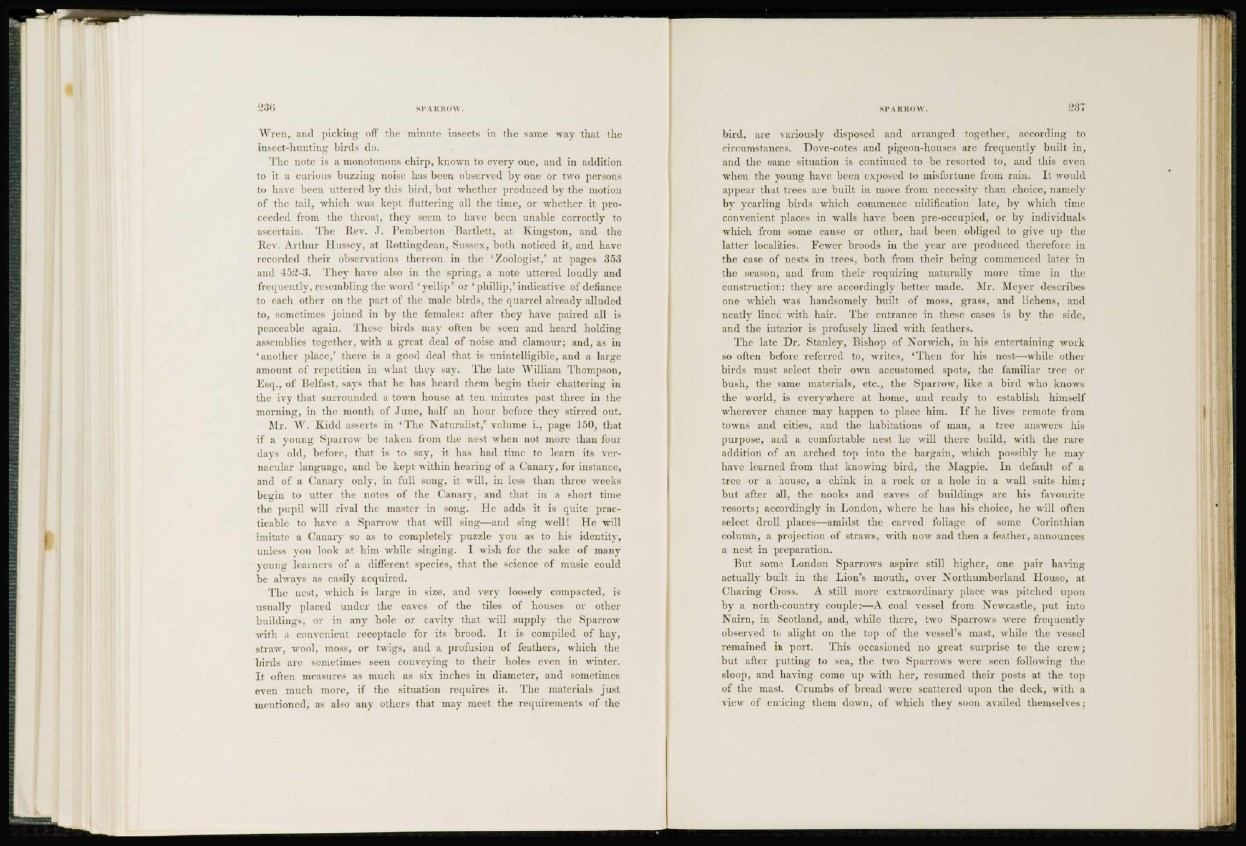
£36 SP IRROW
Wren, and picking off the minute insects in the same way that the
insect-hunting birds do.
The note is a monotonous chirp, known to every one, and in addition
to it a curious buzzing noise has been observed by one or two persons
to have been uttered by this bird, but whether produced by the motion
of the tail, which was kept fluttering all the time, or whether it proceeded
from the throat, they seem to have been unable correctly to
ascertain. The Rev. J. Pemberton Bartlett, at Kingston, and the
Kev. Arthur Husscy, at Rottingdean, Sussex, both noticed it, and have
recorded their observations thereon in the 'Zoologist,' at pages 353
and 452-3. They have also in the spring, a note uttered loudly and
frequently, resembling the word 'yellip' or 'phillip,'indicative of defiance
to each other on the part of the male birds, the quarrel already alluded
to, sometimes joined in by the females: after they have paired all is
peaceable again. These birds may often be seen and heard holding
assemblies together, with a great deal of noise and clamour; and, as in
'another place,' there is a good deal that is unintelligible, and a large
amount of repetition in what they say. The late William Thompson,
Esq., of Belfast, says that he has heard them begin their chattering in
the ivy that surrounded a town house at ten minutes past three in the
morning, in the month of June, half an hour before they stirred out.
Mr. W. Kidd asserts in 'The Naturalist,' volume i., page 150, that
if a young Sparrow be taken from the nest when not more than four
days old, before, that is to say, it has had time to learn its vernacular
language, and be kept within hearing of a Canary, for instance,
and of a Canary only, in full song, it will, in less than three weeks
begin to utter the notes of the Canary, and that in a short time
the pupil will rival the master in song. He adds it is quite practicable
to have a Sparrow that will sing'—and sing well! He will
imitate a Canary so as to completely puzzle you as to his identity,
unless you look at him while singing. I wish for the sake of many
young learners of a different species, that the science of music could
be always as easily acquired.
The nest, which is large in size, and very loosely compacted, is
usually placed under the eaves of the tiles of houses or other
buildings, or in any hole or cavity that will supply the Sparrow
with a convenient receptacle for its brood. It is compiled of hay,
straw, wool, moss, or twigs, and a profusion of feathers, which the
birds are sometimes seen conveying to their holes even in winter.
It often measures as much as six inches in diameter, and sometimes
even much more, if the situation requires it. The materials just
mentioned, as also any others that may meet the requirements of the
SPAR ROW. 337
bird, arc variously disposed and arranged together, according to
circumstances. Dove-cotes and pigeon-houses arc frequently built in,
and the same situation is continued to be resorted to, and this even
when the young have been exposed to misfortune from rain. It would
appear that trees are built in more from necessity than choice, namely
by yearling birds which commence nidification late, by which time
convenient places in walls have been pre-occupied, or by individuals
which from some cause or other, had been obliged to give up the
latter localities. Fewer broods in the year arc produced therefore in
the case of nests in trees, both from their being commenced later in
the season, and from their requiring naturally more time in the
construction: they arc accordingly better made. Mr. Meyer describes
one which was handsomely built of moss, grass, and lichens, and
neatly lined with hair. The entrance in these cases is by the side,
and the interior is profusely lined with feathers.
The late Dr. Stanley, Bishop of Norwich, in his entertaining work
so often before referred to, writes, 'Then for his nest—while other
birds must select their own accustomed spots, the familiar tree or
bush, the same materials, etc., the Sparrow, like a bird who knows
the world, is everywhere at home, and ready to establish himself
wherever chance may happen to place him. If he lives remote from
towns and cities, and the habitations of man, a tree answers his
purpose, and a comfortable nest he will there build, with the rare
addition of an arched top into the bargain, which possibly he may
have learned from that knowing bird, the Magpie. In default of a
tree or a house, a chink in a rock or a hole in a wall suits him;
but after all, the nooks and eaves of buildings arc his favourite
resorts; accordingly in London, where he has his choice, he will often
select droll places—amidst the carved foliage of some Corinthian
column, a projection of straws, with now and then a feather, announces
a nest in preparation.
But some London Sparrows aspire still higher, one pair having
actually built in the Lion's mouth, over Northumberland House, at
Charing Cross. A still more extraordinary place was pitched upon
by a north-country couple:—A coal vessel from Newcastle, put into
Nairn, in Scotland, and, while there, two Sparrows were frequently
observed to alight on the top of the vessel's mast, while the vessel
remained in port. This occasioned no great surprise to the crew;
but after putting to sea, the two Sparrows were seen following the
sloop, and having come up with her, resumed their posts at the top
of the mast. Crumbs of bread were scattered upon the deck, with a
view of enticing them down, of which they soon availed themselves;